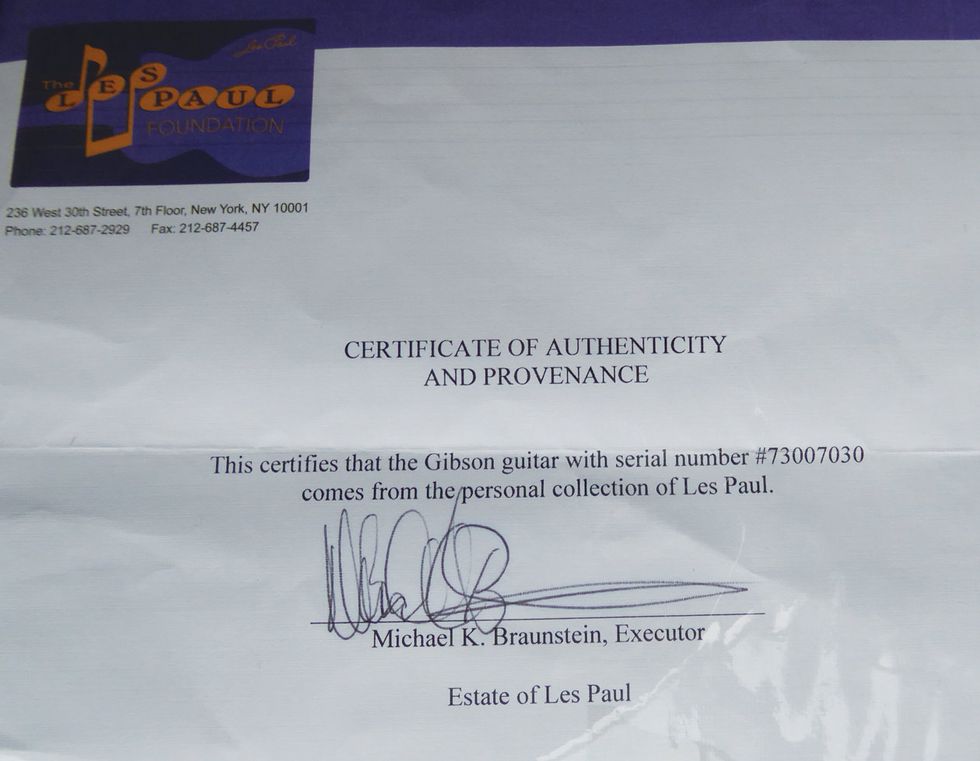Hey Zach,
I think a lot of us always wonder how much value is added to a guitar that was owned by someone famous. I was fortunate enough to obtain Les Paul’s personal 1977 Les Paul Artisan recently. It is signed on the back of the headstock, has a sticker number of G-32, and I have the certificate of authenticity from the executor of Les Paul’s estate. What do you think?
Thanks,
Steve in Minneapolis, MN
Hey Steve,
First, I think we all need to take a minute, take a breath, and appreciate this cool, all-original, mint example of a guitar. The fact that it was owned by Les Paul basically says it all, and the documentation you have puts aside any doubts that it’s the real deal. I’ve heard a thousand stories about guitars owned/played by famous people, with the general mindset that the guitar is therefore rare and worth a boatload of money. Two things: Everyone’s definition of who’s “famous” is very subjective, and without proper documentation, it’s nothing but a story.
The Les Paul Artisan was a more expensive/elaborate variation of the Les Paul Custom and was advertised as a limited-edition model between 1976 and 1982. It’s immediately discernable, with its unique pre-war headstock design, heart-and-floral pearl inlays adorning the ebony fretboard, triple-gold-plated humbuckers, a walnut-finished carved-maple top (ebony and tobacco-sunburst finishes were also available), and a multi-bound top, back, and headstock. Another hallmark of this guitar is the weight: almost 11 pounds!
it’s nothing but a story.
Earlier models were available with two humbuckers, but the three-pickup version became instantly more desirable and Gibson discontinued the two-pickup model by 1979. In 1980, a large Tune-o-matic bridge with a rectangular base replaced the TP-6 that was being used, but otherwise, the Artisan remained unchanged for the most part during its seven-year run.
With an original MSRP of $1,140, which included Gibson’s “Protector” hardshell case, it was the company’s second-highest priced instrument, according to the 1978 Gibson price list. Only the “the Les Paul” model, at $3,000, was more expensive. Between 1976 and 1979 (when Gibson’s shipping totals were available), they produced 2,220 Les Paul Artisans with 1,469 leaving the factory in 1977 alone.
Les Paul’s endorsement contract with Gibson included receiving a sample of every Les Paul variation to verify the quality. According to Michael Cochran, who co-authored 2005’s biography Les Paul in His Own Words with Paul, your 1977 Artisan (serial-number 73007030) was one of those samples that actually resided in the inventor and guitar virtuoso’s bedroom. (The “G-32” sticker was part of Paul’s inventory system.) After Les Paul passed away in 2009, the Les Paul estate contacted Cochran and informed him that Paul wanted him to have one of his guitars. And this Les Paul Artisan is the one Cochran chose.
Documentation guaranteeing the historical provenance of a celebrity-owned instrument is absolutely critical in determining its market value, and this guitar has it.
So, what’s the value of this guitar, knowing that Les Paul owned it? First, we need to start by ascertaining the value without the famous-personality premium attached. In today’s vintage marketplace, a Les Paul Artisan in mint, original condition has a value of $4,500 to $5,000. The real question is how much value do you add when you consider it was once owned by Les Paul himself? It’s a difficult question, but a general guideline for an instrument involving celebrity ownership is typically four to six times the normal value or range, or roughly $18,000 to $30,000. In many cases like this, however, the only way to determine the price (not value) of an instrument is to sell it at a well-advertised auction with a pre-established reserve the owner can live with.
As always, the value is established based on what the market will bear, and you won’t figure that out unless you sell it. When it comes to insurance, don’t skimp. Insure it for what you think it’s worth. If you want to test the waters of the used marketplace, start high. You can always come down, but you can’t go the other way. Remember that to command a premium due to celebrity ownership, you need two important things: a high level of industry notoriety (such as Les Paul’s sterling provenance) and written documentation of who owned it. This instrument has both. Trash or treasure? I don’t think there’s a shred of doubt about what you have!


















